What’s the latest on Georgia’s changing carbon footprint? Here’s a progress report.
This spring, Drawdown Georgia is sharing newly available climate data that examines the progress made since 2017.
What are the big takeaways? Where are we seeing the most progress, and where does the most room for improvement lie?
Keep reading to learn the latest updates from the Drawdown Georgia research team.
Carbon Emissions in Georgia: The Big Picture
The Good News: Georgia’s carbon footprint is shrinking
We have cause to be a little bit optimistic in Georgia, as our state’s carbon footprint has declined in recent years and, as a result, we are contributing less to climate change through some key climate solutions. Despite strong economic and population growth, GHG emissions in our state declined by 5% between 2017 and 2021.
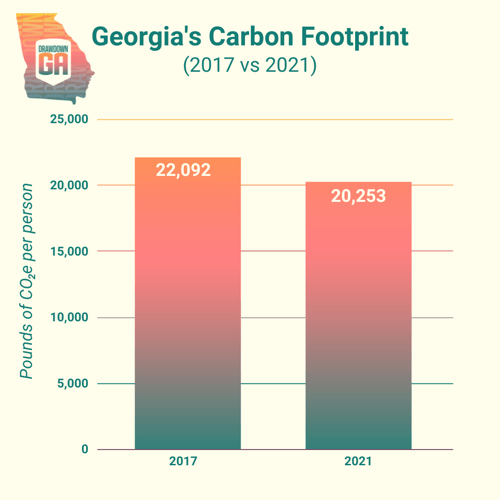
The Complicated News: Emissions from some sectors have increased
This overall reduction in emissions camouflages the fact that some segments of our economy have continued to grow their climate impacts. These emissions are documented in the Drawdown Georgia GHG Emissions Tracker so that we are able to watch how emissions are trending and focus our attention on the sectors where solutions are most needed.
A GHG Emissions Update on Georgia’s changing carbon footprint
As noted above, Georgia's carbon footprint declined by 5% from 2017 (before the Covid-19 pandemic began) to 2021 (a time of Covid recovery), while at the same time the state’s GDP grew a whopping 10%, from $524 billion to $575 billion.
Most of the emissions reductions we’re seeing have come from the use of cleaner sources of electricity generation.
But not every part of our state’s carbon footprint is shrinking at the same rate. Georgia’s consumption of natural gas and diesel fuel has grown compared to five years ago. Were it not for this increase, Georgia's net carbon footprint in 2021 would be 9% lower than in 2017.
In contrast, the “steady state” contributor that has kept Georgia’s carbon footprint in check has been its carbon sinks. Over the last five years, Georgia's forests, soil, and wood products have provided a reliable and significant offset to the state’s carbon emissions.
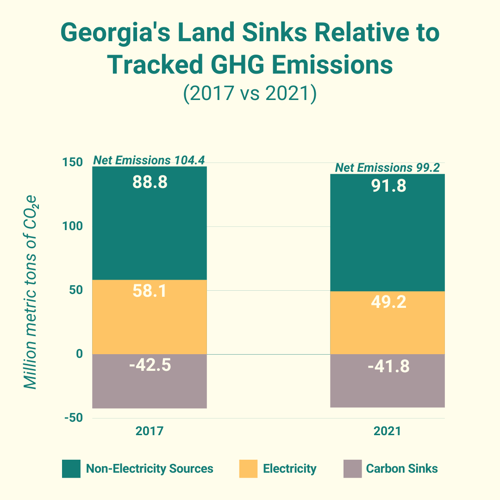
Let’s take a closer look at the different sources of emissions in our state to determine where we’re seeing progress, and where the best opportunities for improvement remain.
Progress on Emissions in the Electricity Sector in Georgia
We’ve seen some of the greatest reductions in carbon emissions in the electricity sector.
Carbon emissions from Georgia’s electric power plants declined by more than 15% between 2017 and 2021. This was primarily driven by the retirement of coal plants, increased reliance on natural gas, the growth of utility-scale solar generation, and the increasing efficiency of electric appliances.
An Increase in Emissions from Ground Transportation
The decarbonization of electricity has moved transportation into the driver’s seat as Georgia's largest source of carbon emissions. Emissions from cars, trucks and SUVs are continuing to increase.
Transportation emissions surpassed pre-pandemic (2017) levels in 2021, emitting nearly 60 million metric tons of carbon dioxide in 2021, 4% more than its 57.3 million metric tons of carbon dioxide (MMtCO2 )in 2017.
While the use of gasoline-powered cars, pick-ups, and SUVs returned to pre-Covid levels, emissions from diesel-fueled medium and heavy-duty trucks and buses grew by 16.1%. This was driven by a boom in online retailing, accounting for nearly all of the sector's growth in emissions.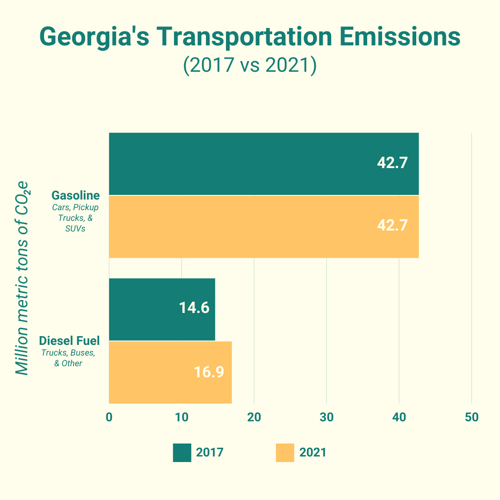
Electricity and HVAC Emissions in Georgia Buildings
Another fuel trade-off – between electricity and natural gas – has also impacted carbon emissions from homes, businesses and industry. While electricity emissions from Georgia buildings and industry have declined, natural gas emissions are increasing.
Emissions Created by Georgia Homes
The residential sector has the largest demand for electricity, and home heating in Georgia still depends primarily on natural gas.
Overall emissions from the consumption of energy in housing declined by 6.0% between 2017 and 2021. However, emissions from non-electric fuels including natural gas and propane increased by nearly 12%, from 6.1 to 6.9 MMtCO2-e between 2017 and 2021.
As of 2021, almost half of households in Georgia still use natural gas for heating, increasing the sector's emissions.
Emissions Created by Commercial Buildings in Georgia
In contrast, businesses and commercial buildings mostly rely on electricity for heating, cooling and other energy uses, and as a result, they have seen a large (16.5%) decrease of nearly 4 MMtCO2-e of GHG emissions between 2017 and 2021. The commercial sector is a relatively small but growing consumer of natural gas in Georgia, which produced a 6.9% increase in its non-electric GHG emissions over the same 5 years.
Offices have also been dialing back occupancy levels due to Covid. As a result, office buildings have seen the largest decline in GHG emissions compared to homes, apartment complexes, businesses, and industry.
Emissions Created by Industry in Georgia
Georgia's greenhouse gas emissions from industry decreased by 2%, principally as a result of its consumption of electricity that is less carbon-intensive.
More than half of industry's GHG emissions are produced on-site, principally from the combustion of natural gas or its use as a feedstock in manufacturing. Emissions from natural gas use in industry increased by about 2% over the past 5 years at the same time that the state’s economy experienced significant growth, with GDP growing from $524 billion to $575 billion between 2017 and 2021.
An Update on Emissions from Food and Agriculture in Georgia
Carbon emissions from food and agriculture declined by 7.1% over the past five years, from 10.1 in 2017 to 9.4 MMtCO2 in 2021. These decreases were achieved in spite of Georgia’s continued leadership in these essential industries.
Agriculture soil management is the most significant contributor to the sector's emissions and is also the main driver of the sector's emission reductions, followed by the decline in GHG emissions from electricity. Manure management was the only sub-sector that increased its emissions (5.9%).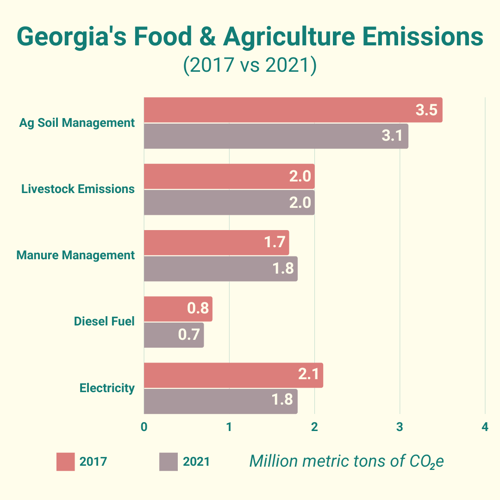
An Update on Carbon Uptake by Georgia’s Natural Land Sinks
The steady-state contributor to Georgia's footprint has been its forests and soils—these land sinks continue to absorb CO2, offsetting nearly a third of Georgia’s emissions. An even more positive story can be told by the state’s wood products that offer an expanding carbon sink.
Georgia’s carbon sinks declined by only 1.6% between 2017 and 2021: while forest carbon uptake decreased by 2.9%, the carbon stored in wood products increased by 3.5%.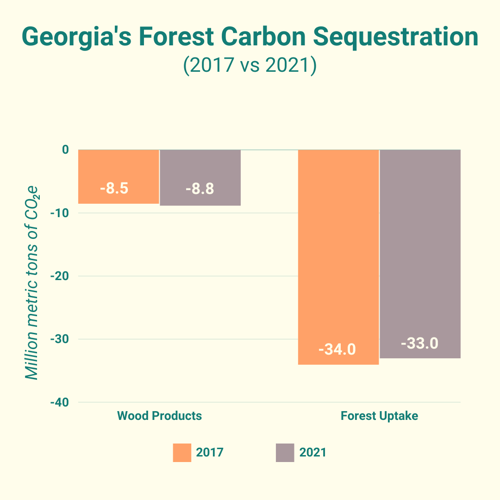
Carbon Emissions in Georgia: Progress and Opportunities
Overall, the Georgia story is a positive one. The carbon footprint of our “average” citizen has declined from 22,092 to 20,252 pounds. That’s an 8% decline--and this is only the beginning of Georgia’s carbon reduction trend.
As more Georgians become involved in the climate movement - by taking steps like embracing electric vehicles, maximizing home energy efficiency, joining demand response programs, composting, installing rooftop solar panels, recycling more, and switching to plant-based diets - Georgia will see even greater progress on drawing down carbon emissions.
Stay Up to Date on Georgia Climate News
Do you want to follow progress on scaling climate solutions in our state and keep your finger on emissions in near real-time? Subscribe now to the Georgia Climate Digest to have the latest in local climate news delivered right to your inbox every other week. 




.png)

.jpg)
